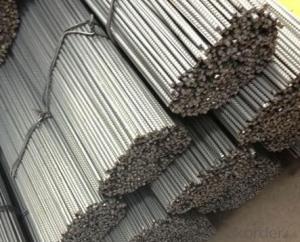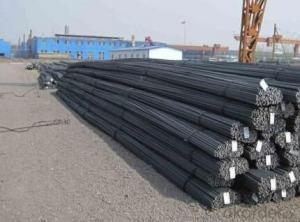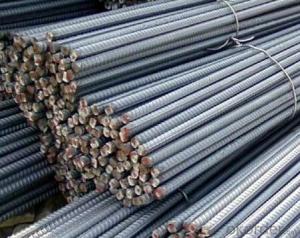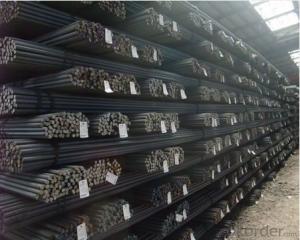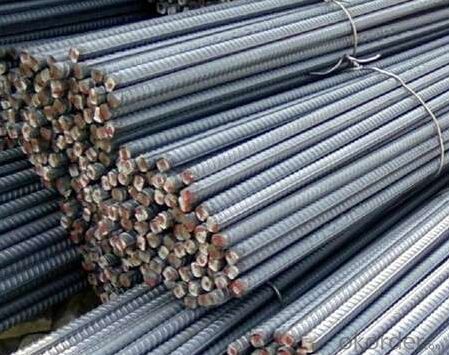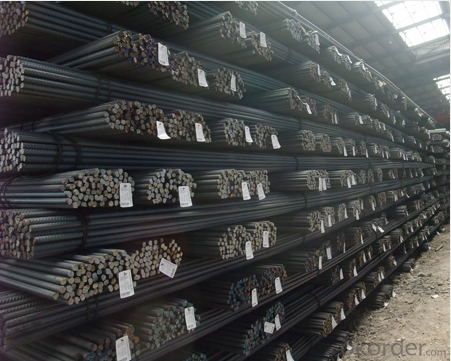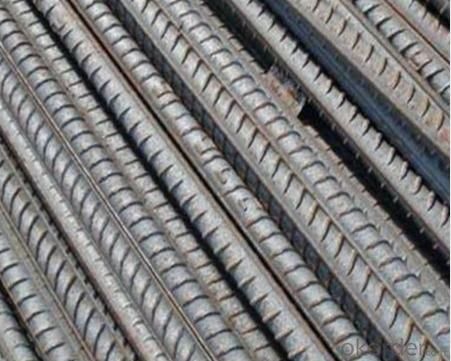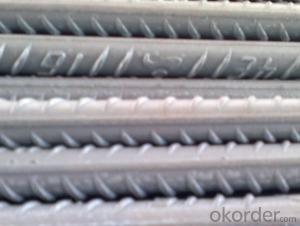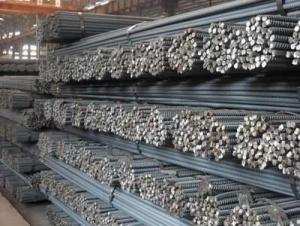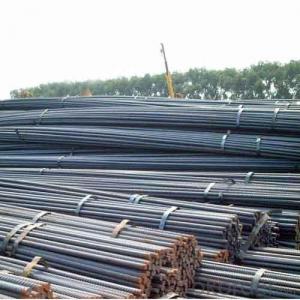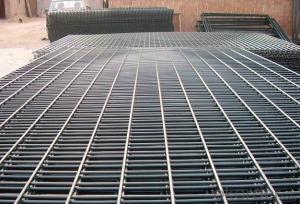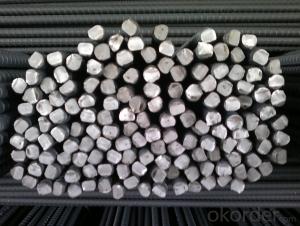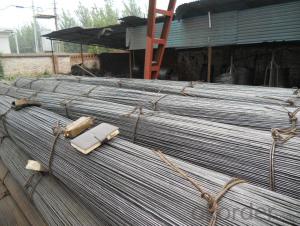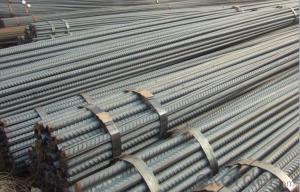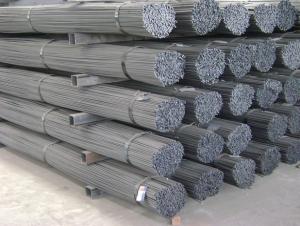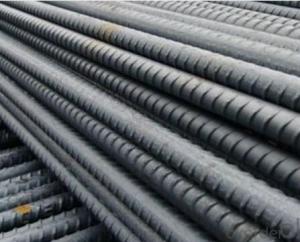Stainless Deformed Steel Rebars with High Quality
- Loading Port:
- Tianjin
- Payment Terms:
- TT OR LC
- Min Order Qty:
- 100 m.t.
- Supply Capability:
- 5000 m.t./month
OKorder Service Pledge
OKorder Financial Service
You Might Also Like
Product Description:
OKorder is offering Stainless Deformed Steel Rebars with High Quality at great prices with worldwide shipping. Our supplier is a world-class manufacturer of steel, with our products utilized the world over. OKorder annually supplies products to European, North American and Asian markets. We provide quotations within 24 hours of receiving an inquiry and guarantee competitive prices.
Product Applications:
Stainless Deformed Steel Rebars with High Quality are ideal for structural applications and are widely used in the construction of buildings and bridges, and the manufacturing, petrochemical, and transportation industries.
Product Advantages:
OKorder's Stainless Deformed Steel Rebars with High Quality are durable, strong, and resist corrosion.
Main Product Features:
· Premium quality
· Prompt delivery & seaworthy packing (30 days after receiving deposit)
· Corrosion resistance
· Can be recycled and reused
· Mill test certification
· Professional Service
· Competitive pricing
Specifications of Deformed Steel Rebars with High Quality:
Standard | GB UK USA | HRB335 HRB400 HRB500 G460B, B500A, B500B,B500C GR40, GR60 | |
Diameter | 6mm,8mm,10mm,12mm,14mm,16mm,18mm,20mm, 22mm,25mm,28mm,32mm,36mm,40mm,50mm | ||
Length | 6M, 9M,12M or as required | ||
Packing | Export standard packing: wrapped by wire rod in bundles | ||
Each bundle weight | 2-3MT, or as required | ||
Trade terms | FOB, CFR, CIF | ||
Payment terms | TT payment in advance or Irrevocable LC at sight. | ||
Delivery Detail | within 45 days after received advanced payment or LC. | ||
Brand name | DRAGON | ||
Theoretical weight and section area of each diameter as below for your information:
Diameter(mm) | Section area (mm²) | Mass(kg/m) | Weight of 12m (kg) | Pcs/ton |
6 | 28.27 | 0.222 | 2.664 | 375.38 |
8 | 50.27 | 0.395 | 4.74 | 210.97 |
10 | 78.54 | 0.617 | 7.404 | 135.06 |
12 | 113.1 | 0.888 | 10.656 | 93.84 |
14 | 153.9 | 1.21 | 14.52 | 68.87 |
16 | 201.1 | 1.58 | 18.96 | 52.74 |
18 | 254.5 | 2.00 | 24 | 41.67 |
20 | 314.2 | 2.47 | 29.64 | 33.74 |
22 | 380.1 | 2.98 | 35.76 | 27.96 |
25 | 490.9 | 3.85 | 46.2 | 21.65 |
28 | 615.8 | 4.83 | 57.96 | 17.25 |
32 | 804.2 | 6.31 | 75.72 | 13.21 |
36 | 1018 | 7.99 | 98.88 | 10.43 |
40 | 1257 | 9.87 | 118.44 | 8.44 |
50 | 1964 | 15.42 | 185.04 | 5.40 |
Chemical Composition: (Please kindly find our chemistry of our material based on JIS as below for your information)
JISG3112 SD390 | Chemical Composition | ||||
C | Mn | Si | S | P | |
0.22 | 1.38 | 0.4 | 0.014 | 0.022 | |
Physical capability | |||||
Yield Strength(N/cm²) | Tensile Strength(N/cm²) | Elongation (%) | |||
620 | ≥400 | 21 | |||
The production process of Steel Rebar
1-Waling beam furnace
2-Roughing rolling group
3-Intermediate rolling train
4-Finishing rolling group
5-Water-cooling device
6-Walking beam cooler
7-Finishing equipment(including the cold scale shear,short feet collection system,
automatic counting device,bundling machine, collect bench)
Usage and Applications of Deformed Steel Rebars with High Quality:
Deformed bar is widely used in buildings, bridges, roads and other engineering construction. Big to highways, railways, bridges, culverts, tunnels, public facilities such as flood control, dam, small to housing construction, beam, column, wall and the foundation of the plate, deformed bar is an integral structure material. With the development of world economy and the vigorous development of infrastructure construction, real estate, the demand for deformed bar will be larger and larger..
Packaging & Delivery of Deformed Steel Rebars with High Quality:
Packaging Detail: products are packed in bundle and then shipped by container or bulk vessel, deformed bar is usually naked strapping delivery, when storing, please pay attention to moisture proof. The performance of rust will produce adverse effect.
Price: Keep lower operating costs so as to offer competitive price for our clients
FAQ:
Q1: Why buy Materials & Equipment from OKorder.com?
A1: All products offered byOKorder.com are carefully selected from China's most reliable manufacturing enterprises. Through its ISO certifications, OKorder.com adheres to the highest standards and a commitment to supply chain safety and customer satisfaction.
Q2: How do we guarantee the quality of our products?
A2: We have established an advanced quality management system which conducts strict quality tests at every step, from raw materials to the final product. At the same time, we provide extensive follow-up service assurances as required.
Q3: How soon can we receive the product after purchase?
A3: Within three days of placing an order, we will begin production. The specific shipping date is dependent upon international and government factors, but is typically 7 to 10 workdays.
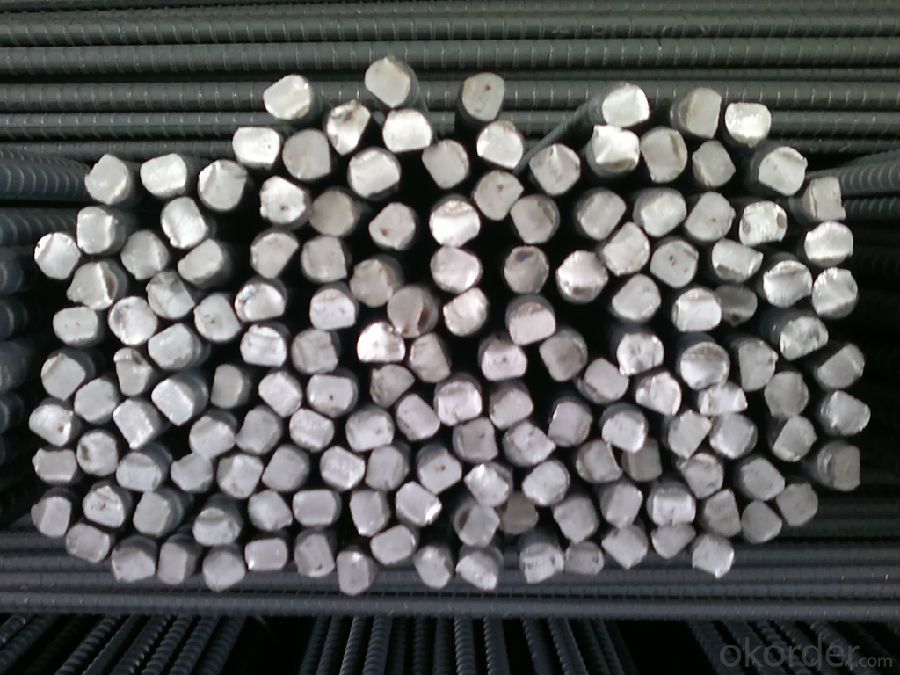
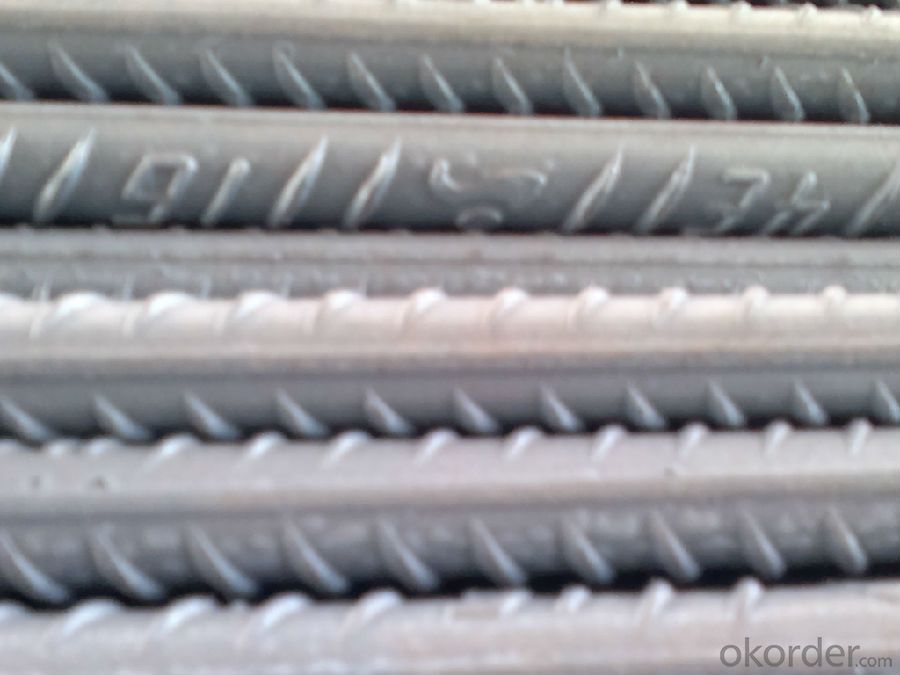
- Q: What are the factors that can affect the lifespan of steel rebars in concrete structures?
- There are several factors that can affect the lifespan of steel rebars in concrete structures. These factors include the quality of the steel used, the level of corrosion protection provided, the exposure to harsh environmental conditions, the presence of cracks or voids in the concrete, and the maintenance and repair practices followed.
- Q: How do steel rebars contribute to the overall durability and service life of concrete structures?
- Steel rebars contribute to the overall durability and service life of concrete structures in several ways. Firstly, they enhance the tensile strength of concrete, which is otherwise weak in tension. By providing reinforcement, rebars help distribute the load evenly, preventing cracks and failure due to excessive stress. Additionally, rebars help to control shrinkage and thermal expansion, minimizing the risk of cracking and ensuring the structural integrity of the concrete. Furthermore, steel rebars are corrosion-resistant, protecting the concrete from the detrimental effects of moisture and other environmental factors. Overall, the presence of steel rebars significantly improves the strength, durability, and longevity of concrete structures.
- Q: What is the role of steel rebars in preventing concrete spalling due to fire?
- The prevention of concrete spalling caused by fire heavily relies on steel rebars. Spalling, which occurs when concrete cracks or flakes off under intense heat, such as during a fire, can be mitigated by embedding steel rebars, also known as reinforcement bars, within the concrete structure. In the event of a fire, the temperature can rapidly rise, causing the moisture within the concrete to transform into steam. This steam generates pressure within the concrete, leading to spalling. However, the presence of steel rebars helps address this issue. Steel possesses a higher melting point than concrete and exhibits exceptional thermal conductivity. When exposed to high temperatures, the steel rebars effectively conduct and disperse heat more efficiently compared to the surrounding concrete. This heat transfer assists in minimizing the temperature gradient within the concrete, thereby reducing the risk of spalling. Moreover, steel rebars serve as reinforcement, ensuring the cohesion of the concrete. In instances of spalling, the rebars aid in maintaining the structural integrity of the concrete by preventing complete disintegration. They provide supplementary strength and support, rendering the concrete more resistant to cracking and breaking. In conclusion, steel rebars are integral in preventing concrete spalling caused by fire. They facilitate heat dissipation, diminish temperature gradients, and offer structural support to the concrete. By enhancing the fire resistance of the concrete, steel rebars contribute to the overall safety and durability of the structure.
- Q: What are the different methods for attaching steel rebars to existing structures?
- There are several methods for attaching steel rebars to existing structures, including drilling and epoxy anchoring, mechanical anchoring using couplers, welding, and using adhesive or resin-based systems. Each method has its own advantages and considerations depending on the specific requirements and conditions of the structure.
- Q: What are the guidelines for the proper installation of steel rebars?
- The proper installation of steel rebars is crucial for ensuring the structural integrity and durability of reinforced concrete structures. Here are some guidelines to follow for their proper installation: 1. Planning and Design: Before beginning the installation, it is important to have a detailed plan and design in place. This includes determining the required rebar size, spacing, and configuration based on the structural requirements and specifications. Consulting structural engineers and adhering to local building codes and regulations is essential. 2. Cutting and Bending: Rebars should be cut and bent accurately according to the design specifications. Proper tools such as rebar cutters and benders should be used to ensure clean cuts and precise bends. Any damaged or corroded rebars should be discarded and replaced. 3. Cleaning and Preparation: The surface of the rebars must be free from any contaminants like rust, oil, dirt, or loose scales before installation. Cleaning the rebars using wire brushes or air blasting is recommended to ensure proper adhesion between the rebar and concrete. 4. Placement and Positioning: The rebars should be placed and positioned accurately as per the design drawings. They should be securely tied or supported using tie wires or rebar chairs to maintain the desired spacing and alignment. Splices should be made in accordance with the design requirements and properly lapped to ensure continuity and strength. 5. Concrete Cover: The rebars should be adequately covered with concrete to protect them from corrosion and provide fire resistance. The concrete cover thickness should meet the design specifications and local building codes. Proper spacing between rebars and formwork should be maintained to allow proper concrete flow and consolidation. 6. Anchorage and Embedment: Adequate anchorage and embedment of rebars are essential for transferring loads and ensuring structural stability. Special care should be taken to provide proper hooks, bends, or mechanical anchorage at the ends of rebars as per the design requirements. The rebars should be properly embedded into the adjacent concrete elements to achieve the desired bond strength. 7. Inspection and Quality Control: Regular inspection should be carried out during the installation process to ensure compliance with the design specifications and quality standards. Any deviations or defects should be identified and rectified promptly. It is important to document the installation process and maintain proper records for future reference. By following these guidelines, the proper installation of steel rebars can be achieved, ensuring the structural strength, longevity, and safety of reinforced concrete structures.
- Q: How do steel rebars affect the maintenance requirements of a structure?
- Steel rebars can significantly impact the maintenance requirements of a structure by enhancing its structural integrity and durability. The use of steel rebars in concrete structures helps prevent cracking, improve load-bearing capacity, and enhance resistance against external forces such as earthquakes and weathering. As a result, the maintenance requirements of the structure are reduced as it becomes more resilient to wear and tear, reducing the need for frequent repairs or replacements.
- Q: Can steel rebars be used in corrosive environments?
- To ensure the longevity and structural integrity of steel rebars in corrosive environments, certain precautions must be taken. Corrosive environments, like those with high levels of moisture, saltwater, or chemical exposure, can accelerate the corrosion process of steel rebars and potentially cause structural damage. To mitigate this risk, there are various strategies that can be implemented. One common approach involves the use of corrosion-resistant reinforcing materials, such as stainless steel rebars or epoxy-coated rebars. These materials offer an additional layer of protection against corrosion and have proven to be effective even in highly corrosive environments. Another approach involves the utilization of corrosion inhibitors, which are chemicals that can be added to the concrete mix or directly applied to the steel surface. These inhibitors create a protective layer around the rebars, inhibiting corrosive agents from reaching the steel and slowing down the corrosion process. Furthermore, it is crucial to maintain an adequate thickness of concrete cover to protect the rebars from exposure to corrosive elements. Sufficient concrete cover acts as a barrier, preventing moisture and other corrosive agents from reaching the steel. Regular inspection and maintenance play a vital role in identifying early signs of corrosion. If corrosion is detected, appropriate measures should be taken to repair or replace the affected rebars, ensuring the structural integrity of the project. In conclusion, while steel rebars can be used in corrosive environments, it is essential to consider the specific conditions and employ the appropriate strategies to protect against corrosion. By using corrosion-resistant materials, applying inhibitors, maintaining proper concrete cover, and conducting regular inspections, the lifespan and performance of steel rebars in corrosive environments can be significantly enhanced.
- Q: Are there any safety concerns related to handling steel rebars?
- Yes, there are safety concerns related to handling steel rebars. Steel rebars are heavy and can cause strain or muscle injuries if not lifted properly. It is important to use proper lifting techniques and equipment such as gloves, back supports, and lifting tools to prevent injuries. Additionally, sharp edges on rebars can pose a puncture or laceration hazard, so it is crucial to wear appropriate protective clothing such as steel-toed boots and gloves. Workers should also be cautious of tripping hazards caused by rebars lying on the ground. Proper housekeeping and keeping the work area clear can help prevent accidents. Lastly, working with rebars involves the use of power tools such as cutting saws, which can generate noise, dust, and debris. Adequate hearing protection, dust masks, and eye protection should be worn to minimize these risks. Overall, following safety guidelines and proper procedures is crucial when handling steel rebars to prevent accidents and injuries.
- Q: How do steel rebars contribute to the overall strength of a structure?
- Steel rebars contribute to the overall strength of a structure by providing reinforcement to concrete. When embedded within the concrete, rebars enhance its tensile strength, preventing cracks and failure under tension. This reinforcement helps the structure withstand external forces, such as wind, earthquakes, or heavy loads, ensuring its stability and durability.
- Q: Can steel rebars be used in coastal areas?
- Yes, steel rebars can be used in coastal areas. However, it is important to note that the rebars need to be properly coated or protected against corrosion due to the higher levels of salt and moisture in coastal environments.
Send your message to us
Stainless Deformed Steel Rebars with High Quality
- Loading Port:
- Tianjin
- Payment Terms:
- TT OR LC
- Min Order Qty:
- 100 m.t.
- Supply Capability:
- 5000 m.t./month
OKorder Service Pledge
OKorder Financial Service
Similar products
Hot products
Hot Searches
Related keywords
